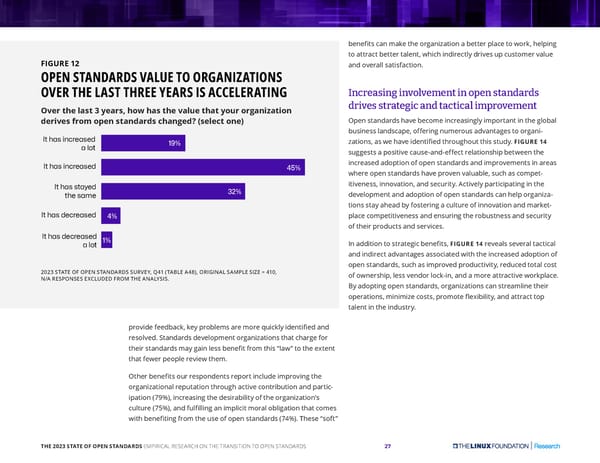benefits can make the organization a better place to work, helping to attract better talent, which indirectly drives up customer value FIGURE 12 and overall satisfaction. OPEN STANDARDS VALUE TO ORGANIZATIONS OVER THE LAST THREE YEARS IS ACCELERATING Increasing involvement in open standards Over the last 3 years, how has the value that your organization drives strategic and tactical improvement derives from open standards changed? (select one) Open standards have become increasingly important in the global business landscape, offering numerous advantages to organi- It ha� incr�a��d FIGURE 14 a lot 19% zations, as we have identified throughout this study. suggests a positive cause-and-effect relationship between the increased adoption of open standards and improvements in areas It ha� incr�a��d 45% where open standards have proven valuable, such as compet- itiveness, innovation, and security. Actively participating in the It ha� �tay�d 32% development and adoption of open standards can help organiza- th� �am� tions stay ahead by fostering a culture of innovation and market- It ha� d�cr�a��d 4% place competitiveness and ensuring the robustness and security of their products and services. It ha� d�cr�a��d 1% FIGURE 14 reveals several tactical a lot In addition to strategic benefits, and indirect advantages associated with the increased adoption of open standards, such as improved productivity, reduced total cost 2023 STATE OF OPEN STANDARDS SURVEY, Q41 (TABLE A48), ORIGINAL SAMPLE SIZE = 410, of ownership, less vendor lock-in, and a more attractive workplace. N/A RESPONSES EXCLUDED FROM THE ANALYSIS. By adopting open standards, organizations can streamline their operations, minimize costs, promote flexibility, and attract top talent in the industry. provide feedback, key problems are more quickly identified and resolved. Standards development organizations that charge for their standards may gain less benefit from this “law” to the extent that fewer people review them. Other benefits our respondents report include improving the organizational reputation through active contribution and partic- ipation (79%), increasing the desirability of the organization’s culture (75%), and fulfilling an implicit moral obligation that comes with benefiting from the use of open standards (74%). These “soft” THE 2023 STATE OF OPEN STANDARDS EMPIRICAL RESEARCH ON THE TRANSITION TO OPEN STANDARDS 27
 The 2023 State of Open Standards Page 26 Page 28
The 2023 State of Open Standards Page 26 Page 28